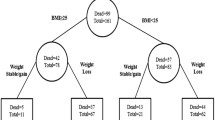Abstract
Objectives
The objective of this follow-up study is to assess the association between different potentially modifiable nutritional risk factors; weight loss after six and 12 months and mortality.
Design and setting
A one year follow-up project among Danish nursing home residents.
Participants
A total of 441 nursing home resident living in 11 nursing homes.
Measurements
Odds ratio was calculated and used to assess the strength of association between different potentially modifiable nutritional risk factors and nutritional status of the participants. The difference in mortality between those who died versus survivors was assessed by means of Fishers Exact Test.
Results
Almost half experienced a loss of weight during the follow-up period. The nutritional risk factors significantly or borderline significantly associated with weight loss were; eating dependency, leaves 25% or more of food uneaten at most meals, chewing and swallowing problems. The prevalence of eating dependency; leaves 25% or more of food uneaten at most meals; swallowing problems and enteral nutrition were higher among those who died than among survivors.
Conclusion
A high percentage of old nursing home residents suffer from weight loss and this is associated with several potentially modifiable nutritional risk factors. Increased combined efforts from all levels of care and wider ranged multidisciplinary nutritional support need to be implemented. Regular routines for assessing weight loss and the potentially modifiable nutritional risk factors cannot be stressed enough.
Similar content being viewed by others
References
Bell CL, Tamura BK, Masaki KH, Amella EJ. Prevalence and Measures of Nutritional Compromise Among Nursing Home Patients: Weight Loss, Low Body Mass Index, Malnutrition, and Feeding Dependency, A Systematic Review of the Literature. JAMDA 2013;14:94–100
Beck A, Ovesen L. Body mass index and energy intake of old Danish nursing home residents and home-care clients. Scand J Caring Sci 2002;16: 86–90
Törmä J, Winblad U, Cederholm T, Saletti A. Does undernutrition still prevail among nursing home resident. Clin Nutr 2013;32:562–8
Milne AC., Potter J, Vivanti A, Avenell A. Protein and energy supplementation in elderly people at risk from malnutrition (Review). Cochrane Database of Systematic Reviews Issue 2. Art. 2009; No.: CD003288. DOI: 10.1002/14651858.CD003288.pub3.
van Bokhorts-de van der Schueren MAE, Guaitoli PR, jansma EP, de Vet HCW. A systematic review of malnutrition screening tools for the nursing home setting. JAMDA Nov 27, 2013. [Epub ahead of print]
Bocock MA, Keller HH, Brauer PM. Defining malnutrition risk for older home care clients. Can J Diet Prac Res 2008;69:171–6
Tamura BK, Bell CL, Masaki KH, Amella EJ. Factors associated with weight loss, low BMI, and malnutrition among nursing home patients: A systematic review of the literature. JAMDA 2013;14:649–55
Morris J, Nonemarker S. Minimum Data Set plus training manual. Natick (MA): 1991;Eliot Press.
Hawes C, Morris JN, Phillips CD, Mor V, Fries BE, Nonemaker S. Reliability estimated for the Minimum Data Set for nursing home residents assessment and care screening (MDS). Gerontologist 1995;35:172–8
Snowden M, McCormick W, Russo J, et al. Validity and responsiveness of the Minimum Data Set. J Am Geriatr Soc 1999;47:1000–4
Mamhidir AG, Ljunggren G, Kihlgren M, Kihlgren A, Wimo A. Underweight, weight loss and related risk factors among older adults in sheltered housing — a Swedish follow-up study. J Nutr Health Aging 2006;10: 255–62
Centers for Medicare & Medicaid Services. Long-Term Care Facility Resident Assessment Instrument User’s Manual version 3.0. Centers for Medicare & Medicaid Services 2013
Beck A, Ovesen L, Schroll M. Validation of the Resident Assessment Instrument triggers in the detection of undernutrition. Age Ageing 2001;30: 161–65
Sullivan DH, Morley JE, Johnson LE, Barber A, Olson JS, Stevens MR, Yamashita BD, et al. The GAIN (Geriatric Anorexia Nutrition) registry: the impact of appetite and weight on mortality in a long-term care population. J Nutr Health Aging 2002;6: 275–81
Nijs KAND, de Graaf C, Kok FJ, van Staveren WA. Effect of family style mealtimes on quality of life, physical performance, and body weight of nursing home residents: cluster randomised controlled trial. BMJ 2006;332: 1180–84
Beck A, Damkjær K, Beyer N. Multifaceted nutritional intervention among nursing-home residents has a positive influence on nutrition and function. Nutrition 2008;24: 1073–80
Bonnefoy M, Cornu C, Norman S, Boutitie F, Bugnard F, Rahmani A, Lacour JR et al. The effects of exercise and protein-energy supplements on body composition and muscle function in frail elderly individuals: a long-term controlled randomised study. Br J Nutr 2003;89: 731–38
Beck A, Beermann T, Kjær S, Rasmussen HH. Ability of different screening tools to predict positive effect on nutritional intervention among the elderly in primary health care. Nutrition 2013;29: 993–99
Sullivan DH, Johnson LE, Bopp MM, Roberson P. Prognostic significance of monthly weight fluctuations among older nursing home residents. J Gerontol 2004;59A: 633–39
Martínez-Reig M, Gómez-Arnedo L, Alfonso-Silguero SA, Juncos-Martínez G, Romero L, Abizanda P. Nutritional Risk, Nutritional Status and Incident Disability in Older Adults. The FRADEA Study J Nutr Health Aging, 2014;18:270–6.
Reider L, Hawkes W, Hebel JR, D’Adamo C, Magaziner J, Miller R, Orwig D, Alley DE. The association between body mass index, weight loss and physical function in the year following a hip fracture. J Nutr Health Aging 2013;17: 91–5.
Author information
Authors and Affiliations
Corresponding author
Rights and permissions
About this article
Cite this article
Beck, A.M. Weight loss, mortality and associated potentially modifiable nutritional risk factors among nursing home residents — A Danish follow-up study. J Nutr Health Aging 19, 96–101 (2015). https://doi.org/10.1007/s12603-015-0439-6
Received:
Accepted:
Published:
Issue Date:
DOI: https://doi.org/10.1007/s12603-015-0439-6




